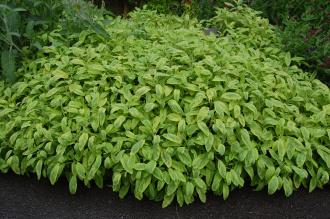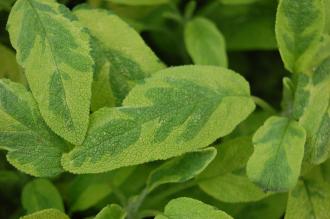
Salvia officinalis ‘Icterina’ (07/06/2014, Kew Gardens, London)
Position: Full sun to partial shade
Flowering period: Summer (occasionally)
Soil: Moist, well drained
Eventual Height: 60cm
Eventual Spread: 60cm
Hardiness: 5b, 6a, 6b, 7a, 7b, 8a, 8b, 9a, 9b
Family: Lamiaceae
Salvia officinalis ‘Icterina’ is an evergreen sub shrub with a domed habit. Its grey/ green leaves have irregular yellow margins, are elliptic with entire margins, up to 7cm long and 2.5cm broad. Its leaves are aromatic when crushed. Mature plants may form a woody stem. Its blue/ purple flowers are two lipped, up to 2cm long and appear on short terminal racemes.
The species Salvia officinalis, commonly known as Common Sage or Garden Sage, is native to to the Mediterranean region. In its native habitat it grows on dry banks and stoney places.
The etymological root of the binomial name Salvia is derived from the Latin salvare, meaning to ‘heal’, in reference to the use of Salvia vulgaris as a medicinal plant. Officinalis is derived from the Latin translating as ‘of the shop’.
The landscape architect may find Salvia officinalis ‘Icterina’ useful as a ground cover plant with variegated leaves. This plant is not attractive to deer. Once established this plant is drought tollerant.
Ecologically, Salvia officinalis ‘Icterina’ flowers are attractive to pollinating insects.

Salvia officinalis ‘Icterina’ Leaf (07/06/2014, Kew Gardens, London)
The Royal Horticultural Society has given Salvia officinalis ‘Icterina’ their prestigious Award of Garden Merit in 1993.
Salvia officinalis ‘Icterina’ prefers moist, fertile, well-drained soils. It tolerates most pH of soil, although it prefers a neutral to alkali p of soil. It dislikes wet soils.
Salvia officinalis ‘Icterina’ requires little maintenance. If required pruning should be carried out in spring before active growth starts.

